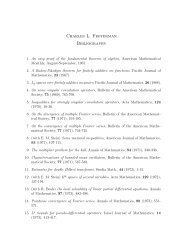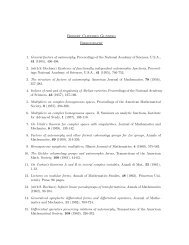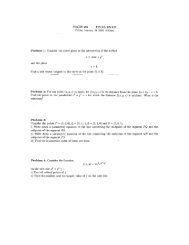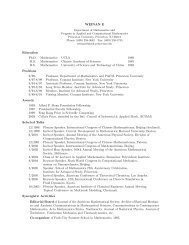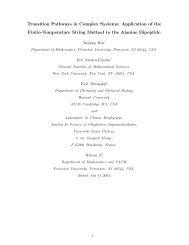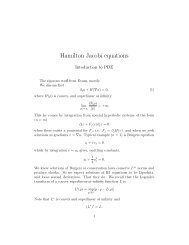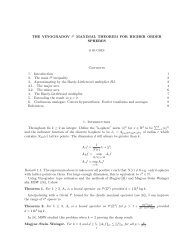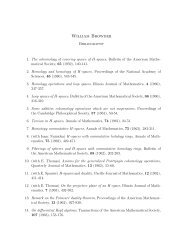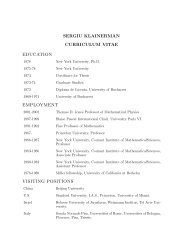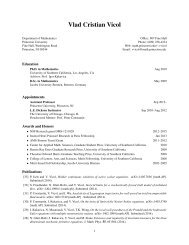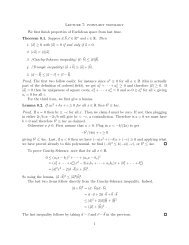The rational Khovanov homology of 3-strand pretzel links
The rational Khovanov homology of 3-strand pretzel links
The rational Khovanov homology of 3-strand pretzel links
You also want an ePaper? Increase the reach of your titles
YUMPU automatically turns print PDFs into web optimized ePapers that Google loves.
2 ANDREW MANION<br />
Before beginning, we will briefly review our conventions on 3-<strong>strand</strong> <strong>pretzel</strong> <strong>links</strong>.<br />
<strong>The</strong> (l,m,n) <strong>pretzel</strong> link will be denoted P(l,m,n). (<strong>The</strong> standard letters to use are p,<br />
q, and r, but we have chosen the letters l, m, and n instead since q will be used for the<br />
quantum grading on <strong>Khovanov</strong> <strong>homology</strong>.) <strong>The</strong> knot P(−3, 5, 7) is shown in Figure 1.<br />
It should remind the reader <strong>of</strong> the general form. For the link P(l,m,n), positive values<br />
<strong>of</strong> l, m, and n represent right-handed <strong>strand</strong>s, and negative values represent left-handed<br />
<strong>strand</strong>s. Note that P(l,m,n) is a knot when zero or one <strong>of</strong> {l,m,n} are even, a twocomponent<br />
link when two <strong>of</strong> {l,m,n} are even and one is odd, and a three-component<br />
link otherwise. <strong>The</strong> ordering <strong>of</strong> l, m, and n does not matter; it is clear that cyclic<br />
permutations <strong>of</strong> the three <strong>strand</strong>s do not change the link, and transpositions simply<br />
amount to turning the link on its head.<br />
For quasi-alternating <strong>links</strong> L, the <strong>Khovanov</strong> <strong>homology</strong> was computed to be thin in [8].<br />
It depends only on the Jones polynomial and signature <strong>of</strong> L. If l, m, and n are all<br />
positive, then P(l,m,n) is actually alternating, so its <strong>Khovanov</strong> <strong>homology</strong> is known<br />
(the Jones polynomials <strong>of</strong> <strong>pretzel</strong> <strong>links</strong> can be found in [5]). Also, mirroring the knot<br />
P(l,m,n) gives P(−l, −m, −n). Since <strong>Khovanov</strong> <strong>homology</strong> enjoys a symmetry under<br />
mirroring (the quantum and homological gradings are replaced by their negatives), we<br />
only need consider P(−l,m,n) when l, m, and n are positive integers.<br />
Figure 1. <strong>The</strong> (−3, 5, 7) <strong>pretzel</strong> knot.




